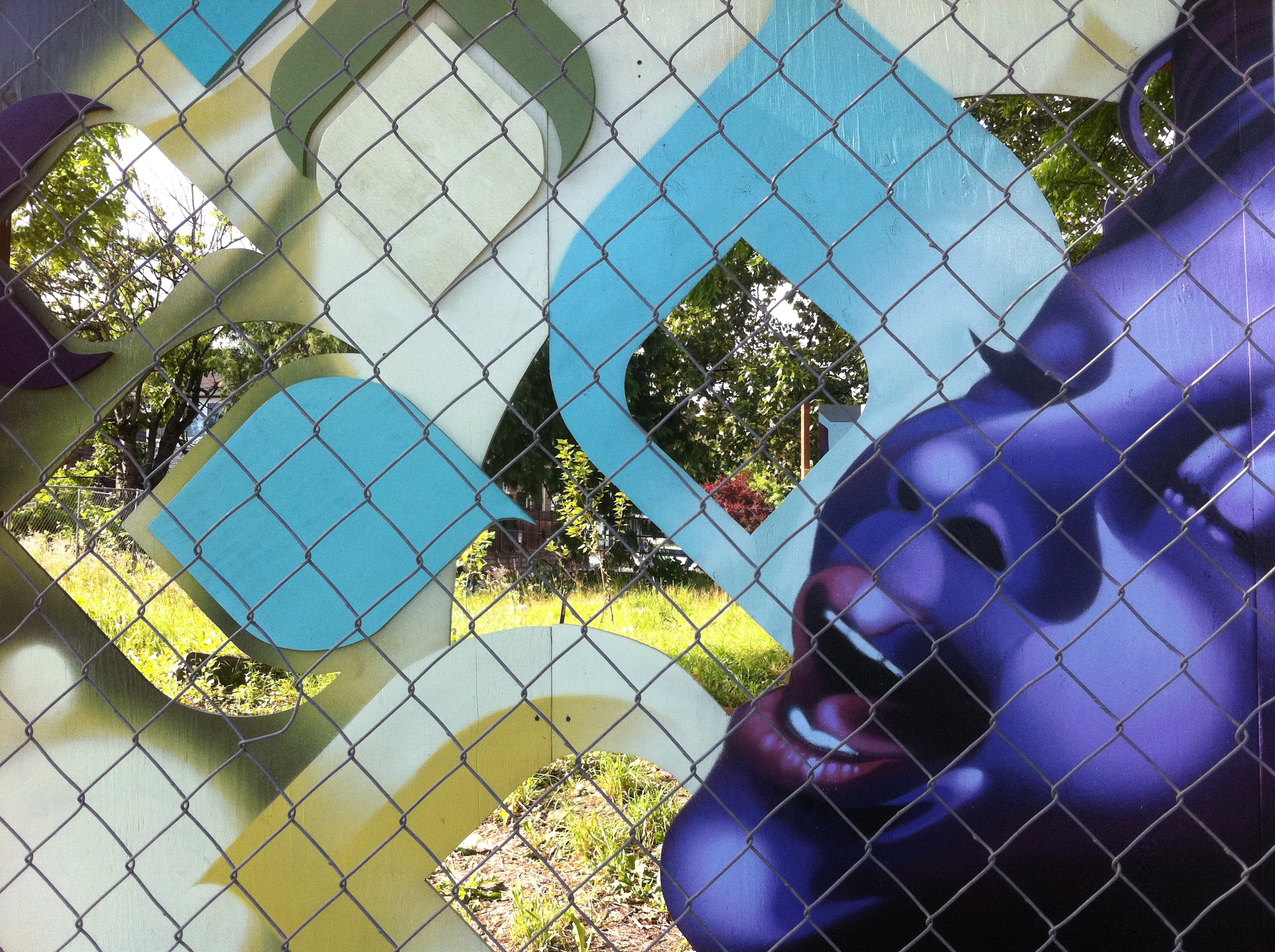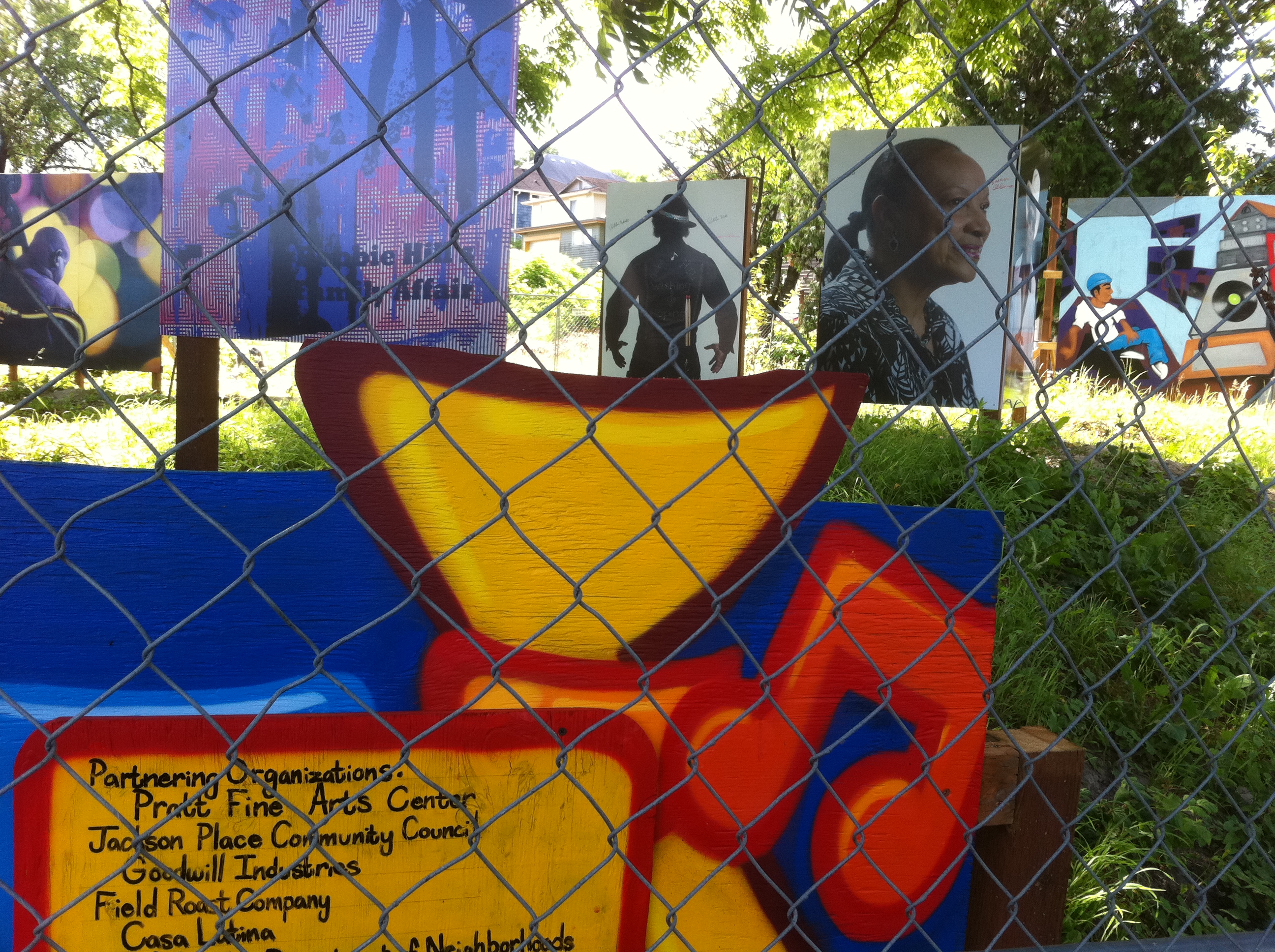 The Jackson Street Music History Project is now up in the vacant lot at 21st and Jackson. Featuring life-sized paintings and photos, the project aims to highlight lesser known yet influential musicians as well as the neighborhood’s well-known music legends.
The Jackson Street Music History Project is now up in the vacant lot at 21st and Jackson. Featuring life-sized paintings and photos, the project aims to highlight lesser known yet influential musicians as well as the neighborhood’s well-known music legends.
One of the neighborhood’s empty lots is owned by the Low Income Housing Institute, scheduled to build affordable senior and work-force housing on South Jackson Street in 2013. Curren approached the group about turning some of its unused property into a temporary art installation. They agreed, leased the property to Curren and gave $750 as seed money for the project.
From there, the project kept building momentum.
Casa Latina, a neighborhood nonprofit that matches immigrants with jobs, offered $100, plus volunteer labor to clean up the lot. The Pratt Fine Arts Center said its young students would help with the prints and research a timeline for display.
The local Goodwill pitched in $500. The Jackson Street Corridor Association contributed $1,000. Field Roast Grain Meat on South Jackson Street gave $500.
(Stay tuned for more on that LIHI project)
 Curren noted that the Jackson Place neighborhood has a history of organizing to protest the arrival of social service nonprofits that make them feel like a “dumping ground,” according to the Times. Protested organizations include Casa Latina’s arrival and, currently, a proposed Crisis Solutions Center to be operated by the DESC.
Curren noted that the Jackson Place neighborhood has a history of organizing to protest the arrival of social service nonprofits that make them feel like a “dumping ground,” according to the Times. Protested organizations include Casa Latina’s arrival and, currently, a proposed Crisis Solutions Center to be operated by the DESC.
The Jackson Street Music History Project is a chance for the neighborhood to unite behind something positive, he said.
“At the core of it, it had to be positive, it had to be working for something rather than against something,” he said.
For more information, check out the project’s Facebook page.

It’s a shame that residents who have joined together to question the siting of the DESC’s Crisis Center in the Jackson Place neighborhood are viewed as “working against” something positive. In fact, it’s quite the opposite. Residents in the Jackson Place community are actively working to keep their neighborhood a safe place. It’s everyone’s duty and responsibility as a community member to question programs that do not follow the proper review and permitting process – particularly if these programs have the potential to create a long-term, negative impact to an already fragile community.
Art installations and music projects enhance a community, but it doesn’t make a community. A community is built on people working together, actively engaging with others to create a safe place to call their own.
Agree. This art installation is a positive for the neighborhood, drawing support from a diverse group of organizations. Inexplicably, the CD News headline writer focused on the most inflammatory two paragraphs of the Times’ long story.
I have lived here four years, and the neighborhood indeed feels like it is teetering; positive development emerges (Wonder Bread apartments, SPD’s DMI roundup, the impending senior center), but strong negatives persist: broad-daylight violence at 23rd and Jackson, brazen drug dealing beside the Pratt Park playground; halfway houses setting up shop to invite ex-felons into the neighborhood. This neighborhood, like any other, asks the city for attention and protection. But this neighborhood, unlike many others, seemingly must shout for that same attention/protection. I applaud Jackson Place’s inclination to protect. I believe the neighborhood would be stronger if more of us shared that sensibility.
The article does not state folks protesting the DESC siting are viewed as working against something positive, just something. You added the positive. Instead the article points out what every community organizer knows, public participation increases when there is a crisis or something to fight. Try and get folks to come out on a Saturday to clean up their neighborhood or build something and you may end up feeling frustrated.
The Casa Latina labor essential to this project just highlights the ridiculous opposition to their siting in our neighborhood. We couldn’t have asked for better neighbors; they help every Jackson Place neighborhood clean-up, they helped paint the NW Tofu Restaurant when it got bombarded with gang graffiti and they helped clear the lot this project is on. Not nearly the criminal influence many neighbors warned of. There is no guarantee but I doubt the sky will fall if DESC is sited here as well.
I agree it can be cumbersome to get large-scale community support on any issue, whether it be in regards to community art or raising awareness about the siting of county sponsored programs.
To compare Casa Latina to DESC’s jail diversion facility is incorrect and ill-informed. When did it become legal to site a jail diversion in a residential neighborhood? And when did people start turning a blind eye to important issues going on their community?
How have you managed to mire so many different issues into on stew and assumed so much about the motives of JP citizens. Many of us supported or had no interest in Casa Latina. Mexicans seeking work has always been a fairly non-threatening issue in my book. There was a very open dialog and process and a group that promised to be a working part of the neighborhood – and they have proven themselves.
DESC and the City Administration have been stalking the nieghborhood, making secret plans, and cricumventing the law in an effort to spend available money on a foolish, poorly planned, project. The various governmental organizations in Seattle have gotten into bead with dubious budget consumers (non-profits ooh how wonderfull). The sole purpose of these marriages is to seek out funds and spent those funds, primarily to assure they have dominance and control over any money that may become available now or in the future. DESC is a consumer. City of Seattle is a credit issuer. Problem is the City is not as smart as BoA or Chase.
And back to the point. How is it thaw we are comparing Mexican workers, art, and a prison as if they are similar issues? WTF?
Tom there is nothing wrong with your title. People will insert their own agendas wherever they see the opportunity.
People in this comment section can act like they have no problem with Casa Latina, but it is a fact that many neighbors vehemently opposed Casa Latina when they were attempting to secure the site. There was a collective effort against Casa Latina. There is similar opposition to the DESC crisis center. People are working against something they see as a negative in the neighborhood. It is not inflammatory to state that Jackson Place residents have a history of viewing the neighborhood as a “dumping ground” for social services. It is not wrong to say that many residents are against that. They say it on their own every chance they get but when the Times or Tom F. says it they get all defensive and redundant.
Some people in the neighborhood worked for something they see as positive: an art project that highlights the musical history of the neighborhood. And some people in the neighborhood are working against something they see as negative: another social service agency. The JP residents that are against the DESC project clearly have a preference for arguing semantics and appear extremely paranoid and defensive to the point they will hijack a post about an art installation to further their rhetoric about DESC and their opposition to the crisis center. It’s not a good look for them.
Thank you for writing the story about this installation Tom, even if things become derailed by certain JP residents who will take every opportunity to bash the crisis center. The art project is wonderful and I am glad you chose to cover it.
If agendas are at work here, the editor should have the courage to acknowledge his own, by way of rather weak-sauce journalism. He took the most inflammatory 10 percent from the Times 900-word article, and made them into 60 percent of his 100-word rehash. He slammed a community group with a headline cobbled from a partial quote that hardly represented the spirit of the Times piece. No one has “hijacked” this post; rather, as the CD News editor apparently anticipated, the folks slammed in the headline responded. Nothing like generating a little site traffic, I guess.
For the record, I am not a Jackson Place resident, but I wholeheartedly agree that the DESC project can bring no good to the neighborhood.
Brian, I have written at length about the DESC facility several times, such as here: http://www.centraldistrictnews.com/2011/01/28/jackson-place- and here: http://www.centraldistrictnews.com/2011/01/31/opponents-of-j
I don’t know what agenda you think I have, but I think the coverage of the debate has been very fair.
In this story, I chose the supposedly “inflammatory” (I don’t see what is inflammatory about him saying he is happy to be working for something rather than against) parts of the ST story because I thought they represented an interesting lesson about the potential for a community art project to bring people, groups and businesses together. That’s all. I don’t see how you are getting that I have assigned a value (positive or negative) to efforts opposing the DESC facility.
I have, perhaps, assigned a positive value to the JSMHP, but I’d say a pro-public art stance is understandable for a community blog.
Tom, thanks for coming clean about your bias toward community beautification projects. I hope this is your first step toward recovery. Hopefully you will rant and rave the next time a mural is put up in the community to give the anti-grafitti activists some red meat to knaw on.
Tom,
Don’t take things personal. Realize that the issue is a touchy one, people in the community are witnessing a park dying. space that could be used to provide parking space for a inner city park (Dr. Livazzo) and bring some chance for true buetification is instead finalizing gentrafication on a grander scale. What the city has chosen to do is effectively close a park to outsiders and doom it to less that savy patrons instead.
The fact that there is not an outlet for this voice make you the the source of outlet. Instead of being defensive take it as an opportunity to see the trauma that exsists surrounding this issue and a chance to cultivate your empathy for what truely is a sad occurance in the for the park and the neighbors of it.
That said, Good Job Ryan Curran for provide some possitivety to truely a negative situation. When the new housing goes up I will be sure to move, it is just going to kill the park. SAD really.
The city wants you to move out Arland.
LIHI is developing the lot, LOW INCOME HOUSING INSTITUTE; different from DESC (Downtown Emergency Service Center). Does anybody know the difference or are they all an alphabet soup of service agencies designed to bring poor people into the neighborhood? If it were a private homeowner renting out his dilapidated housing stock to the same poor people would you be putting up the same resistance? It seems to me the objection is organizations of people doing something together that is so threatening to these people. Please move to Yakima or Marysville where they have organized resistance to low income housing development, you live in the Central District now.
who said anything about the park closing?